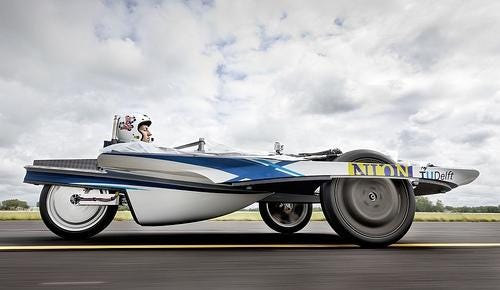Composites Lighten Solar Car
August 8, 2011

The wind drag of a new solar-powered car is ultra-low -- about as much as a side mirror of a truck driving at 62 miles per hour.
New materials, combined with efficient design, have produced a lightweight car that is targeting a first place finish in the 2011 World Solar Challenge in Australia in October.
A team at the Delft University of Technology in the Netherlands has developed the Nuna6 vehicle. Tipping the scales at just 320 pounds, the Nuna6 is half the weight of the first Nuna model developed by the Nuon Solar Team in 2001. It is also the smallest car in the Nuna family, with a length of 14.6 feet.
The Nuon Solar Team is formed every two years from Delft University of Technology students who take 18 months off from their studies to work on the solar car. The team members have backgrounds in electrical engineering, aerospace engineering, industrial design, mechanical engineering, and applied physics. They have won four competitions but were upset in 2009 by a Japanese team. A University of Michigan team finished third.
"Stiffness is key for our design," Woytek Bode, who is responsible for structures and production on the Nuna6, told me. "Because the car is so big and light, the restricting factor is stiffness and not strength. There are only a few areas [mainly near the suspension] that are critical on strength."
The body is made from a carbon fiber sandwich structure to maximize stiffness. Intermediate modulus fibers are woven into a weave by a company from Sweden called Oxeon. "They produce a fabric called TeXtreme that is at the moment one of the most advanced fabrics available. The key feature of the fabric is that it is woven with 20mm tapes, while regular fabrics are woven with rovings. This has a result that the TeXtreme fabric can be much more flat, and the fibers are straighter. This results in a higher stiffness."
The matrix resin is a special polymer from DSM called Turane that is durable and tough and is said to have very good mechanical properties. The structural foam in the composite sandwich is a product called Rohacell from Evonik Industries of Essen, Germany. Nuna6 uses foam with densities varying from 0.00112lb/in3 to 0.00397lb/in3. This special aerospace-grade foam is resistant to high temperatures, is easy to form, and has good mechanical properties, says Bode.
Click on the image below to view a slideshow of the Nuna6 production process:


About the Author(s)
You May Also Like



